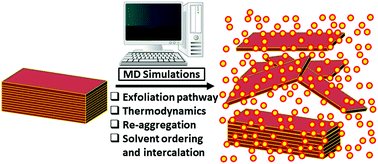Disentangling the liquid phase exfoliation of two-dimensional materials: an “in silico” perspective
Abstract
Liquid Phase Exfoliation (LPE) is one of the most successful synthetic roots for the preparation of two-dimensional (2D) materials from their bulk counterparts. In recent years, significant progress has been accomplished for the development and modification of LPE techniques. However, precise identification of the hierarchical steps of the molecular mechanism of LPE remains to some extent elusive. Additionally, the a priori choice of suitable solvents for successful exfoliation and dispersion of various layered materials poses a challenge for both academia and industry. Computational methods, particularly Molecular Dynamics (MD) simulations with classical force-fields have contributed a great deal towards the understanding of the underlying mechanism of LPE, providing remarkable insights into the molecular-level details of the solvent-material interactions at the nanoscale and predicting “good” and “bad” solvents for exfoliation as well as stabilization of the dispersed state. With an intention to build up a unified understanding, in this perspective article, we summarize the recent advancements of molecular simulation techniques employed to decipher the mechanism of LPE, pointing out the key features of molecular interactions and identifying several thermodynamic parameters governing the phenomena. In addition, we outline the necessary characteristics of solvent molecules, essential for their use as “good” solvents towards LPE. Also, we highlight the limitations of simulation methods for the modelling of LPE. We believe that this article will be beneficial for the selection of solvents for the synthesis of novel 2D materials via LPE and will also provide a comprehensive view to computational material scientists towards the development of novel simulation protocols for investigating and analysing such complex molecular events.

- This article is part of the themed collection: PCCP Perspectives


 Please wait while we load your content...
Please wait while we load your content...